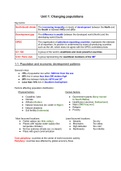Interview
IB Geography (SL/HL) - Unit 1, Unit 2, and Unit 3 summaries (straight 7)
- Course
- Institution
These well-organized and clear notes will guarantee you a straight 7 as they were written alongside my teacher (with 20 years of IB geography teaching experience) and are in perfect line with the textbook. Its images, diagrams, colours and much more as well as its direct references to case studies ...
[Show more]



